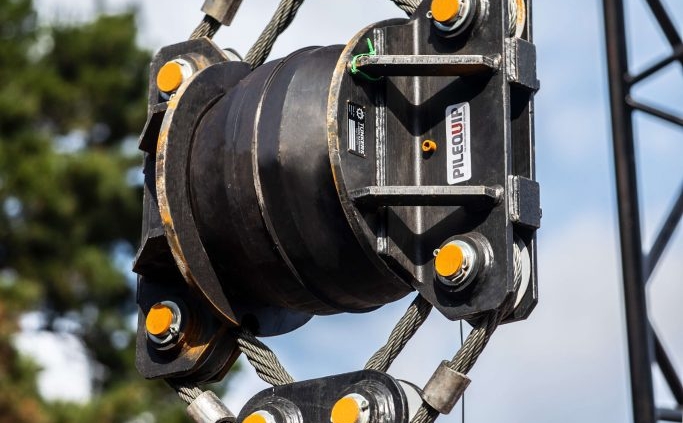The Environmental Benefits of Using Vibration Dampers for Pile Driving
Pile driving is a critical process in construction, especially for establishing strong foundations in buildings, bridges, and other infrastructure projects. However, traditional pile driving methods often come with environmental challenges, primarily due to the significant vibration and noise generated during operations. These vibrations can negatively affect surrounding structures, local ecosystems, and community health. To address these concerns, the industry has increasingly adopted vibration dampers for pile driving, a technology designed to reduce the impact of vibrations during pile installation.
This article explores the environmental benefits of using vibration dampers for pile driving, highlighting how they contribute to more sustainable and responsible construction practices.
Understanding Vibration Dampers for Pile Driving
Vibration dampers for pile driving are devices attached to pile driving equipment to absorb and reduce the vibrations transmitted to the surrounding environment. These dampers work by dissipating energy generated during the impact or driving process, minimizing the propagation of vibrations into the soil and nearby structures.
By incorporating vibration dampers, construction projects can achieve smoother pile driving with reduced environmental disturbance. These devices come in various designs, including elastomeric dampers, hydraulic dampers, and spring-based systems, each suited for different project requirements.
Reducing Noise Pollution
One of the most noticeable environmental benefits of vibration dampers for pile driving is their ability to reduce noise pollution. Traditional pile driving generates loud banging noises that can disrupt nearby communities and wildlife habitats.
By absorbing shock and vibration energy, these dampers reduce the intensity and frequency of noise emitted during pile driving. Lower noise levels help construction sites comply with local noise regulations, protect workers’ hearing, and reduce disturbance to residents and animals. In urban or sensitive ecological areas, the use of vibration dampers plays a significant role in enabling construction projects to proceed without causing excessive noise pollution.
Minimizing Ground Vibrations and Structural Impact
Ground vibrations from pile driving can cause damage to adjacent buildings, underground utilities, and infrastructure. Excessive vibrations may lead to structural cracks, settlement, or even failure in extreme cases. Furthermore, these vibrations can disturb soil layers, affecting underground ecosystems and water flow patterns.
Vibration dampers for pile driving effectively reduce the amplitude and range of vibrations transmitted through the ground. This control helps protect nearby structures from damage and preserves the integrity of surrounding soils. In environmentally sensitive sites, such as those near wetlands or protected green zones, mitigating vibrations is crucial to maintaining ecosystem stability.
Protecting Wildlife and Natural Habitats
Construction projects near natural habitats pose risks to local wildlife, especially species sensitive to vibration and noise disturbances. Frequent pile driving without vibration control can disrupt animal behaviors, breeding cycles, and feeding patterns.
By reducing the intensity of vibrations and noise, vibration dampers for pile driving lessen the impact on wildlife. This technology enables projects to coexist more harmoniously with natural habitats, reducing stress and displacement of animals. In some cases, this reduction in disturbance is essential to comply with environmental protection laws and conservation efforts.
Enhancing Worker Health and Safety
While primarily an environmental consideration, the benefits of vibration dampers for pile driving also extend to the health and safety of construction workers. Continuous exposure to high vibration and noise levels can lead to occupational hazards such as hearing loss, vibration white finger, and other musculoskeletal disorders.
By incorporating vibration dampers, construction sites provide a safer and more comfortable working environment. This improvement contributes to better productivity and reduces long-term health risks, indirectly supporting environmental sustainability by promoting responsible labor practices.
Supporting Sustainable Construction Practices
The growing emphasis on sustainable and green construction practices has driven the adoption of vibration dampers for pile driving. Sustainable construction aims to minimize environmental footprints while delivering durable and safe infrastructure.
Using vibration dampers aligns with these goals by reducing noise, vibrations, and the associated environmental damage. Additionally, projects that implement such technologies often experience fewer delays due to community complaints or regulatory restrictions, contributing to efficient resource use and reduced waste.
Regulatory Compliance and Community Relations
Many regions have stringent regulations regarding permissible vibration and noise levels during construction. Non-compliance can result in fines, project delays, or mandatory cessation of work. Vibration dampers for pile driving help contractors meet these regulatory requirements by controlling environmental impacts.
Moreover, maintaining good community relations is vital for construction projects, especially in populated areas. The reduced environmental disturbances enabled by vibration dampers foster positive perceptions among local residents and stakeholders. This goodwill can be instrumental in securing permits and support for current and future projects.
Conclusion
Vibration dampers for pile driving represent a significant advancement in environmentally responsible construction technology. By reducing noise pollution, minimizing ground vibrations, protecting wildlife, enhancing worker safety, and supporting regulatory compliance, these devices contribute to more sustainable pile driving operations.



Leave a Reply
Want to join the discussion?Feel free to contribute!